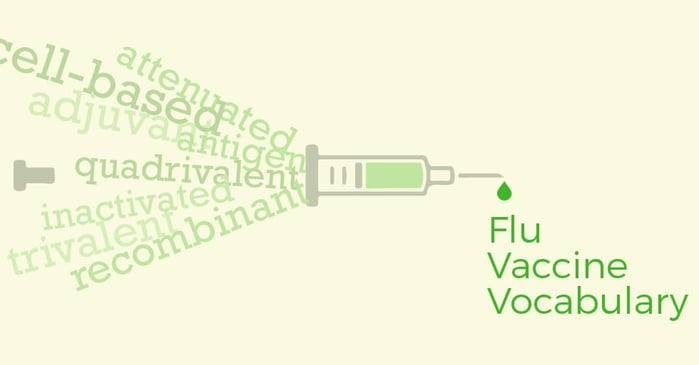Flu Vaccine Vocabulary You Need to Know

 Over the past decade, the general public has come to hear more terminology about vaccines than ever before. Thanks in part to the growth of anti-vaccination groups and resulting media coverage, your average person has been exposed to terms such as "live attenuated ," "quadrivalent" and "recombinant." While the medical field is unanimous in its support for vaccines for those individuals healthy enough to have them, the confusion surrounding these terms can still remain an obstacle for some. Today's post aims at demystifying these terms in the hopes that knowledge will lead to an informed decision (and more flu shots).
Over the past decade, the general public has come to hear more terminology about vaccines than ever before. Thanks in part to the growth of anti-vaccination groups and resulting media coverage, your average person has been exposed to terms such as "live attenuated ," "quadrivalent" and "recombinant." While the medical field is unanimous in its support for vaccines for those individuals healthy enough to have them, the confusion surrounding these terms can still remain an obstacle for some. Today's post aims at demystifying these terms in the hopes that knowledge will lead to an informed decision (and more flu shots).
Flu:
Short for "influenza," the flu is a seasonal virus. There are three types of flu. A types, of which there are hundreds of strains, are the most virulent and most dangerous. B types, of which there are two, are far weaker strains but still common. Type C strains are both rare and weak.
Vaccine:
A protective treatment that prepares the body's immune system for possible infection by a specific strain or strains of a virus. This is accomplished by introducing just the protein that causes the immune response (the antigen) to the body, not the part that makes the body sick. The goal is to produce the immune response early, so that if the person is infected later, the body can immediately begin to fight the virus off.
The flu vaccine varies by source of the antigen, the manufacturing process, and the dose.
SOURCE
Attenuated:
A virus that has been weakened but is still considered "live." The immune response to these vaccines are nearly identical to those of the actual virus strain, but can cause side effects and extremely rarely, dangerous complications.
Inactivated:
A virus that has been sliced apart before use in a vaccine. These vaccines result in a weaker immune response, so will often be combined with an adjuvant (see below).
Recombinant:
Through genetic engineering, the DNA segments of a virus that cause the immune response are injected into a bacteria or animal cell, which in turn will produce the needed antigen.
MANUFACTURING
Once the CDC has identified the strains most likely to arrive in North America, it produces candidate vaccine viruses for the vaccine manufacturers. The manufacturers are responsible for replicating it in sufficient numbers to create serum for distribution throughout the country.
Egg-based:
For decades, the leading way to replicate the virus for use in vaccines has been using fertilized chicken eggs. A chicken egg is injected with the virus, where it replicates over 72 hours. The virus is then separated from the egg contents, treated, purified, and created into a serum.
Cell-based:
In 2017, a flu vaccine using this technique was available. Instead of the chicken egg, the virus is inserted into a mammalian cell, where it duplicates. This technique offers many advantages: It is quicker, as a vast number of cells can be frozen and stored until needed; it is more dependable, since it does not have to rely on the availability of millions upon millions of fresh, fertilized chicken eggs (especially in the case of a sudden pandemic); and it produces viruses that are closer to the actual virus out in the community, since reproduction in a chicken egg can slightly alter the virus' composition.
DOSE
Trivalent/Quadrivalent:
Flu shots in the US contain the vaccines for 3 (tri-) or 4 (quadri-) of the most likely strains to reach North America. Trivalent shots will contain vaccines for 2 Type A strains and 1 Type B strain, while quadrivalent shots will contain those plus the only other Type B strain.
Regular/High Dose:
There are dosage options for older individuals, including a "high-dose" version with more antigens. These are created in order to provide older individuals, who tend to have weaker immune responses, with a vaccine that will result in a good enough immune response to provide protection. Another option for older individuals is a shot with an adjuvant (see below).
Adjuvant:
An ingredient added to a vaccine that increases the immune response.
We hope that this list of terms helps you better understand the flu vaccine and your choices as a consumer!
Editor's Note: This post was originally published in December 2019 and has been updated for freshness, accuracy and comprehensiveness.
![EOScu Logo - Dark - Outlined [07182023]-01](https://blog.eoscu.com/hubfs/Eoscu_June2024/Images/EOScu%20Logo%20-%20Dark%20-%20Outlined%20%5B07182023%5D-01.svg)




